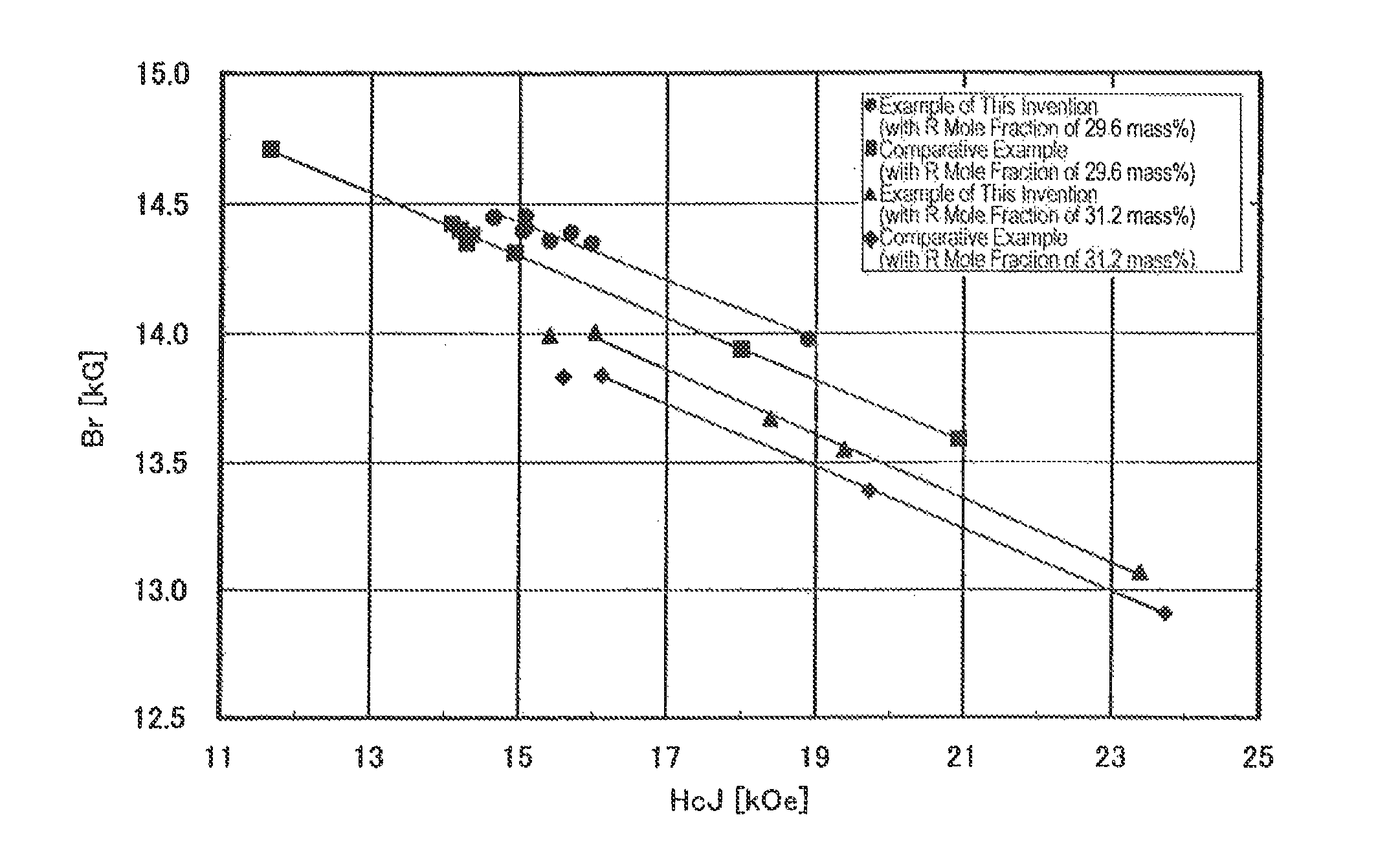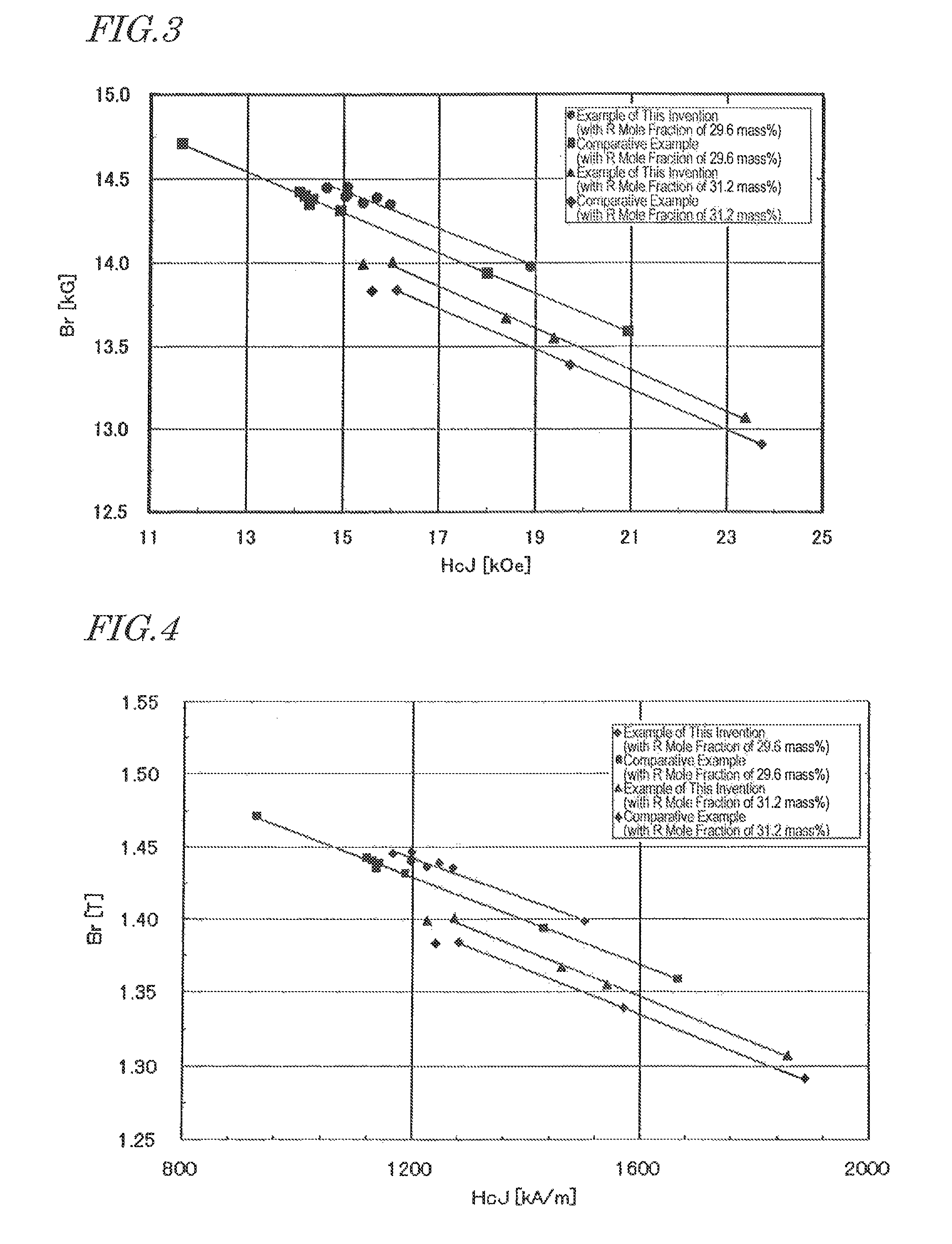Method for producing R-T-B sintered magnet
a technology of r-t-b and rtb, which is applied in the direction of magnetic materials, magnetic bodies, transportation and packaging, etc., can solve the problems of reducing coercivity, reducing remanence, and easy loss of irreversible flux, so as to reduce remanence and increase coercivity
- Summary
- Abstract
- Description
- Claims
- Application Information
AI Technical Summary
Benefits of technology
Problems solved by technology
Method used
Image
Examples
example 1
[0096]An alloy with a target composition was obtained by mixing together Nd with a purity of 99.5 mass % or more, Tb and Dy with a purity of 99.9 mass % or more, electrolytic iron and low-carbon ferroboron as main ingredients, along with other target additive elements that were added as either pure metals or alloys with Fe, and the mixture was melted. The melt thus obtained was cast by strip casting process, thereby obtaining a plate alloy with a thickness of 0.3 to 0.4 mm.
[0097]Next, that alloy was decrepitated with hydrogen in a pressurized hydrogen atmosphere, heated to 600° C. within a vacuum, and then cooled to obtain a coarse powder. To this coarse powder, further added was 0.05 mass % of zinc stearate. And the powder and the lubricant were mixed together.
[0098]Next, the mixture was subjected to a dry pulverization process using a jet pulverizer (i.e., jet mill) within a nitrogen gas jet, thereby obtaining an R-T-B based alloy powder A with any of the particle sizes D50 shown ...
example 2
[0118]R-T-B based alloy powders A and B, having the compositions and particle sizes D50 shown in the following Table 4, were obtained by dry pulverization process as in Example 1 described above.
[0119]The details are shown in the following Table 4. The analysis was carried out by inductively coupled plasma atomic emission spectroscopy (ICP-AES). The contents of oxygen, nitrogen and carbon were obtained as analyzed values by a gas analyzer.
[0120]
TABLE 4R-T-B based alloy powder AR-T-B based alloy powder Bcomposition (mass %)D50composition (mass %)NoFeNdDyBCoAlCuGaONC(μm)FeNdDyBCoAl26Bal29.50.00.950.90.150.10.10.110.020.105.9Bal19.510.00.950.90.1527Bal29.50.00.950.90.150.10.10.100.030.105.9Bal19.510.00.950.90.1528Bat29.50.00.950.90.150.10.10.100.020.104.8Bal19.510.00.950.90.1529Bal29.50.00.950.90.150.10.10.100.020.104.8Bal19.510.00.950.90.1530Bal29.50.00.950.90.150.10.10.090.020.104.8Bal19.510.00.950.90.1531Bal29.50.00.950.90.150.10.10.100.030.105.932Bal27.52.00.950.90.150.10.10.120.02...
example 3
[0130]R-T-B based alloy powders A and B, having the compositions and particle sizes D50 shown in the following Table 7, were obtained by dry pulverization process as in Example 1 described above.
[0131]The details are shown in the following Table 7. The analysis was carried out by inductively coupled plasma atomic emission spectroscopy (ICP-AES). The contents of oxygen, nitrogen and carbon were obtained as analyzed values by a gas analyzer.
[0132]
TABLE 7R-T-B based alloy powder AR-T-B based alloy powder BComposition (mass %)D50Composition (mass %)NoFeNdDyBCoAlCuGaONC(μm)FeNdDyBCoAlCuGaO39Bal28.40.00.91.90.110.10.10.0590.0340.0584.0Bal20.010.00.942.00.100.10.10.09740Bal28.40.00.91.90.110.10.10.0590.0340.0584.0Bal20.010.00.942.00.100.10.10.07041Bal28.40.00.91.90.110.10.10.0590.0340.0584.0Bal20.010.00.942.00.100.10.10.075
[0133]Those powders A and B were mixed together at any of the mixing ratios shown in Table 7 with 0.4 mass % of methyl caprylate added as a lubricant to the powders bein...
PUM
 Login to View More
Login to View More Abstract
Description
Claims
Application Information
 Login to View More
Login to View More - R&D
- Intellectual Property
- Life Sciences
- Materials
- Tech Scout
- Unparalleled Data Quality
- Higher Quality Content
- 60% Fewer Hallucinations
Browse by: Latest US Patents, China's latest patents, Technical Efficacy Thesaurus, Application Domain, Technology Topic, Popular Technical Reports.
© 2025 PatSnap. All rights reserved.Legal|Privacy policy|Modern Slavery Act Transparency Statement|Sitemap|About US| Contact US: help@patsnap.com



